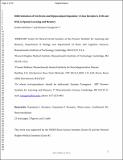Differentiation of forebrain and hippocampal dopamine 1-class receptors, D1R and D5R, in spatial learning and memory
Author(s)
Tonegawa, Susumu; Sarinana, Joshua
DownloadTone4Sarinana et al, Final.pdf (1005.Kb)
OPEN_ACCESS_POLICY
Open Access Policy
Creative Commons Attribution-Noncommercial-Share Alike
Terms of use
Metadata
Show full item recordAbstract
Activation of prefrontal cortical (PFC), striatal, and hippocampal dopamine 1-class receptors (D1R and D5R) is necessary for normal spatial information processing. Yet the precise role of the D1R versus the D5R in the aforementioned structures, and their specific contribution to the water-maze spatial learning task remains unknown. D1R- and D5R-specific in situ hybridization probes showed that forebrain restricted D1R and D5R KO mice (F-D1R/D5R KO) displayed D1R mRNA deletion in the medial (m)PFC, dorsal and ventral striatum, and the dentate gyrus (DG) of the hippocampus. D5R mRNA deletion was limited to the mPFC, the CA1 and DG hippocampal subregions. F-D1R/D5R KO mice were given water-maze training and displayed subtle spatial latency differences between genotypes and spatial memory deficits during both regular and reversal training. To differentiate forebrain D1R from D5R activation, forebrain restricted D1R KO (F-D1R KO) and D5R KO (F-D5R KO) mice were trained on the water-maze task. F-D1R KO animals exhibited escape latency deficits throughout regular and reversal training as well as spatial memory deficits during reversal training. F-D1R KO mice also showed perseverative behavior during the reversal spatial memory probe test. In contrast, F-D5R KO animals did not present observable deficits on the water-maze task. Because F-D1R KO mice showed water-maze deficits we tested the necessity of hippocampal D1R activation for spatial learning and memory. We trained DG restricted D1R KO (DG-D1R KO) mice on the water-maze task. DG-D1R KO mice did not present detectable spatial memory deficit, but did show subtle deficits during specific days of training. Our data provides evidence that forebrain D5R activation plays a unique role in spatial learning and memory in conjunction with D1R activation. Moreover, these data suggest that mPFC and striatal, but not DG D1R activation are essential for spatial learning and memory.
Date issued
2015-08Department
Massachusetts Institute of Technology. Department of Biology; Picower Institute for Learning and MemoryJournal
Hippocampus
Publisher
Wiley Blackwell
Citation
Sariñana, Joshua, and Susumu Tonegawa. “Differentiation of Forebrain and Hippocampal Dopamine 1-Class Receptors, D1R and D5R, in Spatial Learning and Memory: D1R AND D5R IN SPATIAL LEARNING AND MEMORY.” Hippocampus 26.1 (2016): 76–86.
Version: Author's final manuscript
ISSN
1050-9631
1098-1063